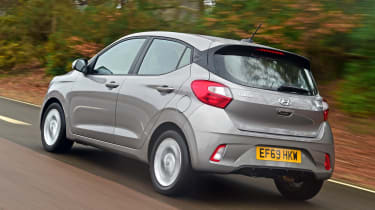New Hyundai i10 2020 review
The Hyundai i10 is aiming to prove that the city-car sector is still alive and kicking...just.

The all-new i10’s enhanced technology and improved practicality have been joined by a little extra refinement, all of which makes it a challenger in the city-car class. We’ll put it head to head with its closest rivals soon, but for now the Hyundai looks like it offers a decent balance of affordability, usability, modernity and refinement for an urban runaround.
Is the city-car sector dead? Brands have been leaving this area of the market, but Hyundai remains confident it can make the formula work with its new i10.
It’s doing so with a tech offensive and a more practical body for this third-generation car. As well as offering more inside, Hyundai has sharpened up the styling to keep it fresh for image-conscious buyers in the class.
Our SE Connect test car is the sweet spot of the range, and although the i10 still offers a relentlessly grey cabin, you do get an eight-inch touchscreen with Android Auto and Apple CarPlay. This works well, with decent graphics and plenty of screen area to show lots of functions, giving it a big-car feel that’s backed up by the i10’s dynamics.
Standard kit also includes autonomous emergency braking plus lane-keep assist. Air-con, DAB, cruise control and a rear camera are also fitted, but wireless charging (as part of the £1,000 Tech Pack that also includes built-in nav) isn’t available on this trim level.
Used - available now
No matter, as the i10 is best as it comes, and at £13,495 as standard, it’s not a cheap car anyway. For this the Hyundai is powered by a 66bhp 1.0-litre three-cylinder naturally aspirated petrol engine.
It’s best described as adequate, because it doesn’t feel all that keen, but the 96Nm of torque feels strong enough. It helps to deliver a 14.6-second 0-62mph sprint, but is more useful in the ebb and flow of city traffic, where the i10 can be left in gear.
However, the five-speed manual’s shift action is positive if you want to work it, and the steering is a good weight for around town (but not too light so it feels nervous on the motorway), while the ride is acceptable.
It’s on the firmer side, which again helps with stability at higher speeds and makes the handling feel fairly secure on country roads, but the i10 still soaks up most of what city streets throw at it fairly well.
This grown-up feel is reinforced by the roomy rear of the interior. Combined with a 252-litre boot, it means the i10 is nearly as practical as some smaller superminis. Claimed economy of 54.3mpg and 104g/km emissions should mean low costs and round off a convincing package.












